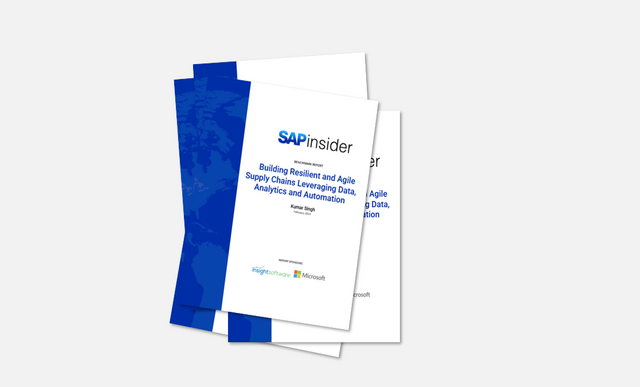Bringing Automation and Collaboration into the Supply Chain: Overall Trends and the Path Forward
In recent months, SAPinsider has conducted a significant amount of research around solutions for digital supply chain management (SCM) — particularly in the areas of automation and collaboration, both of which our research has revealed as playing a significant role in the successful modernization and optimization of supply chains. To build on that research, and to gain deeper insight into how SAP partners are supporting customers in these areas to help with this transition, we also recently interviewed leadership at itelligence, a company that has extensive experience in these areas.
Here, I share some key insights gleaned from the survey of SAP customers we conducted in the areas of automation and collaboration in the supply chain, as well as what we learned from our conversations with intelligence leadership, including how they view the market and the ways in which they support customers on the journey to a digital supply chain.
Automation and Collaboration Are Key to Digital Supply Chains
In the upcoming SAPinsider benchmark report “Supply Chain Transformation Strategies: IT vs. Operations in SAP Customer Landscapes,” we dive deep into what leaders — respondents to our survey that have accelerated growth due to digital transformation in the supply chain — do differently from others when it comes to responding to market pressures. We found that all survey respondents recognize the importance of meeting customer demands for faster delivery, better quality, and cheaper prices, but the laggards — the bottom 30% of respondents, which are companies that have not yet begun a digital transformation of the supply chain — fail to recognize the importance of collaborating with suppliers. Leaders, on the other hand, prioritize this collaboration. Additionally, laggards have yet to adopt the SAP Integrated Business Planning (IBP) solution or any sort of cloud-based internal collaboration tools for supply and operations planning (S&OP), while leaders have implemented IBP.
Explore related questions
In addition to prioritizing collaboration, leaders have started to meet the challenge of more complicated supply chains with multiple channels and more advanced strategic sourcing practices, including the use of advanced automation technologies, such as artificial intelligence (AI) and machine learning. Leaders also pay more attention to the security of their data and their processing abilities because they have implemented Internet of Things (IoT) devices and applications, which multiply the volume of data collected. They integrate this data into harmonized master data solutions, leverage it in planning and forecasting, and use it to automatically update inventory planning.
6 Ways to Pave the Way to a Digital Supply Chain
Taking advantage of automation and collaboration means moving to a digital model — so what does this mean for those that are managing or operating a supply chain? When asked about where SAP customers need to concentrate their efforts to pave the way to a successful digital supply chain, the senior director of cloud solutions at itelligence listed six key areas of focus:
- Collaboration with suppliers: Supply chain managers and their suppliers need to collaborate and provide a certain amount of visibility to optimize operations. They need to exchange electronic information quickly in a mobile framework. Right now, most SAP customers do this through email and with some electronic data interchange (EDI). Solutions such as itelligence’s it.x-EDIconnect (which supports the secure exchange of SAP ERP system data with suppliers) and it.vendor (which provides a database overview of suppliers that do not use EDI) help ensure visibility and transparency between partners and suppliers.
- Self-service order tracking: Amazon, FedEx, and UPS have made us all grow accustomed to tracking everything we order, and end customers of supply chain organizations expect the same capability.
- Accounts payable (AP) automation: While AP might fit more into the finance department, it still must work hand in glove with supply chain operations. Procured goods need to integrate with finance to know when to file electronically and make payments.
- SCM master data management: To execute SCM processes at the right time, SAP customers need to accumulate generic data, manage and govern it appropriately, and use it in the right applications to plan, make, deliver, service, and retire products.
- Rebate and promotion management: Rebates and promotions — used in the right way — can play a significant role in drawing customers and improving customer retention.
- Warehouse management: More accurate inventory means more efficient operations and better customer service. Optimized implementations of solutions such as SAP Extended Warehouse Management (SAP EWM) are key to effective warehouse management.
What Does This Mean for SAPinsiders?
Based on the findings from our research on automation and collaboration in the supply chain, and our conversations with itelligence leadership, the following will help SAP customers plan for a successful transition to a digital supply chain:
- Whether or not you use SCM applications such as itelligence solutions, address the key areas identified above. Any organization managing or operating a supply chain can surely improve the bottom line and possibly accelerate growth with improved collaboration tools, automated AP, better data management, improved customer retention, lower inventory, and shorter lead times.
- You have the data, make the most of it. You have all the information and tools you really need in your SAP ERP system. If you cannot figure out how to maximize the value of that data, bring in a partner or consultant to help you modernize.
- Identify the problems that need solving and the technologies that can help your organization solve them. Sustainability and performance analytics, AI, IoT, demand-driven planning, and mobile applications will draw the most investment over the next two years, but take the time to hold meetings between IT and operations to identify the operational problems that need solving and where you can accelerate growth with better technology.
- SCM operations managers and IT professionals should align on their organizations’ current capabilities. IT professionals and SCM operations managers need to communicate and align better on the reality of their situations. Operations managers tend to have a more optimistic outlook. While they may have a deeper understanding of the operations capabilities, they likely do not have the strengths they claim in security and harmonized data.
Following this strategic guidance should help SAP customers plan for a digital transformation of the supply chain in a way that leverages what they already have in their SAP ERP system and generates measurable business value. For additional insights and lessons learned, look for the upcoming SAPinsider benchmark report “Supply Chain Transformation Strategies: IT vs. Operations in SAP Customer Landscapes.”
Pierce Owen can be reached at Pierce.Owen@wispubs.com.
itelligence, NTT DATA Business Solutions – is a leading global SAP full-service provider. www.itelligencegroup.com




